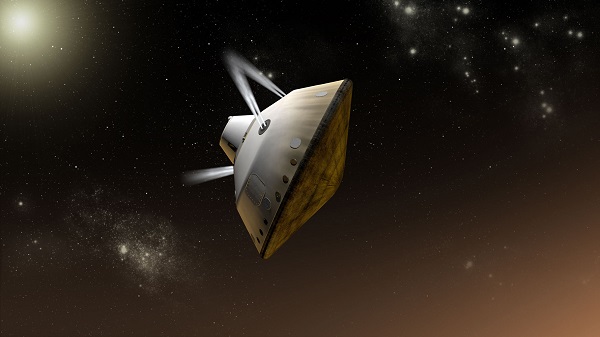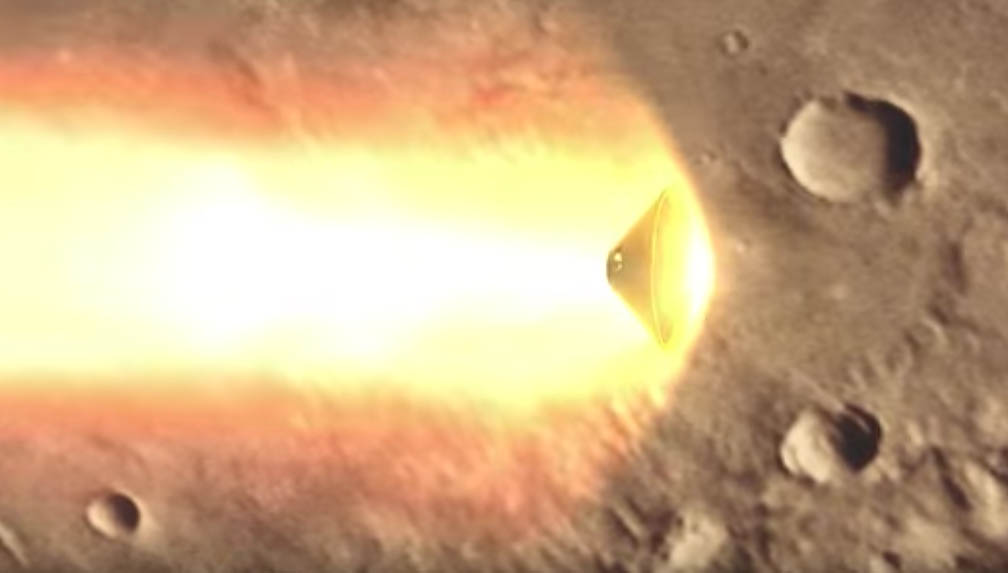In the coming decades, a number of missions are planned for Mars, which include proposals to send astronauts there for the first time. This presents numerous logistical and technical challenges, ranging from the sheer distance to the need for increased protection against radiation. At the same time, there is also the difficulty of landing on the Red Planet, or what is referred to as the “Mars Curse“.
To complicate matters more, the size and mass of future missions (especially crewed spacecraft) will be beyond the capacity of current entry, descent, and landing (EDL) technology. To address this, a team of aerospace scientists released a study that shows how a trade-off between lower-altitude braking thrust and flight-path angle could allow for heavy missions to safely land on Mars.
The study, which recently appeared in the Journal of Spacecraft and Rockets, was authored by Christopher G. Lorenz and Zachary R. Putnam – a researcher with The Aerospace Corporation and an assistant professor of aerospace engineering at the University of Illinois, respectively. Together, they investigated different landing strategies to see which could overcome the “Mars Curse”.
Simply put, landing on Mars is a difficult business, and only 53% of spacecraft sent there since the 1960s have made it to the surface intact. To date, the heaviest vehicle to successfully land on Mars was the Curiosity rover, which weighed 1 metric ton (2,200 lbs). In the future, NASA and other space agencies plan to send payloads their with masses ranging from 5 to 20 tons, which is beyond conventional EDL strategies.
In most cases, this consists of a vehicle entering the Martian atmosphere at hypersonic speeds of up to Mach 30 and then slow down quickly due to air friction. Once they reach Mach 3, they deploy a parachute and fire their retrorockets to slow down further. The problem with heavier missions, according to Putnam, is that parachute systems do not scale well with increasing vehicle mass.
Unfortunately, retrorocket engines burn a lot of propellant, which adds to overall vehicle mass – which means heavier launch vehicles are needed and missions end up costing more. In addition, the more propellant a spacecraft needs, the less volume it can spare for payload, cargo, and crew. As Prof. Putman explained in a Illinois Aerospace press release:
“The new idea is to eliminate the parachute and use larger rocket engines for descent… When a vehicle is flying hypersonically, before the rocket engines are fired, some lift is generated and we can use that lift for steering. If we move the center of gravity so that it’s not uniformly packaged, but heavier on one side, it will fly at a different angle.”

For starters, Lorenz and Putnam investigated the pressure differential which occurs around a vehicle when it hits Mars’ atmosphere. Basically, the flow around the vehicle is different on the top than on the bottom of the vehicle, which creates lift in one direction. This life can be used to steer the vehicle as it decelerates through the atmosphere.
As Putnam explained, the craft could either use its retrorockets at this point to land the craft accurately, or it could conserve its propellant to land the largest amount of mass possible – or a balance between the two could be struck. In the end, it’s a question of at what altitude you fire the rockets. As Putnam put it:
“The question is, if we know we’re going to light the descent engines at, say, Mach 3, how should we steer the vehicle aerodynamically in the hypersonic regime so that we use the minimum amount of propellant and maximize the mass of the payload that we can land? To maximize the amount of mass we can [land] on the surface, the altitude at which you ignite your descent engines is important, but also the angle your velocity vector makes with the horizon—how steep you’re coming in.”
Herein lies another important aspect of the study, where Lorenz and Putnam assessed how to make the best use of the lift vector. What they found was that it was best to enter the atmosphere of Mars with the lift vector pointed down so the vehicle is diving, and then (depending on time and velocity) to switch the lift up and fly along at low altitude.

“This enables the vehicle to spend more time flying low where the atmospheric density is higher,” said Putnam. “This increases the drag, reducing the amount of energy that must be removed by the descent engines.”
The conclusions of this study could inform future missions to Mars, especially where heavy spacecraft transporting cargo and crews are concerned. While this EDL strategy would make for a more nerve-wracking landing, the odds of the crews landing safely and not succumbing to the “Great Galactic Ghoul”.
Beyond Mars, this study could implications for landing on other Solar bodies that have thin atmospheres. Ultimately, Lorenz and Putnam’s strategy of a hypersonic entry and a lower-altitude braking thrust could assist with crewed missions to all kinds of celestial bodies.
Further Reading: Illinois Aerospace, ARC

